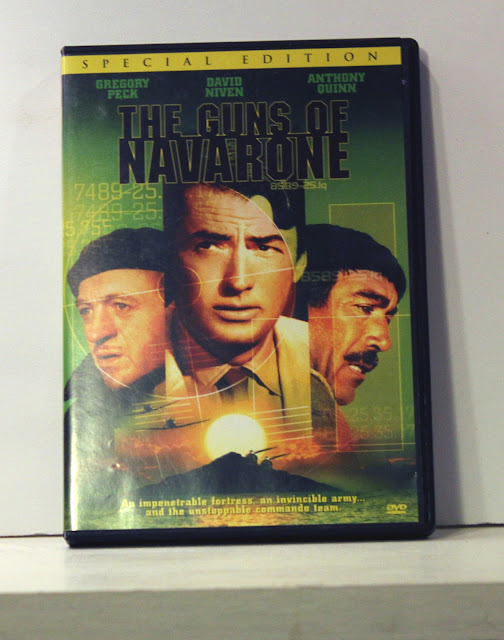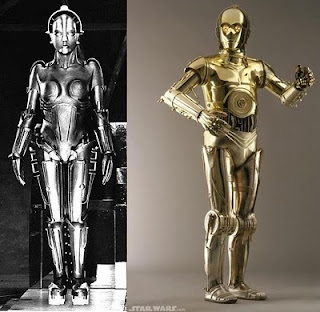THE GUNS OF NAVARONE (1961)
Guest writer Phil Congleton returns with a very April, very cool classic film...
 |
| Photo by Phil Congleton |
April is a good month to visit the Guns of Navarone (1961), a World War II, epic drama, centered around the European theatre of the war. Why April? First, two main cast members in the film were born in April. Anthony Quinn was born on April 21st, 1915. A year later, Gregory Peck was born on April 5th, 1916. The man, who wrote the novel, that the film is based on, Alistair MacLean, was born on April 28th, 1922. Columbia Pictures would get the opportunity to distribute the film worldwide. It would make its royal, world premiere, in London on April 27th, 1961. Apparently, it had a pretty famous audience, including Queen Elizabeth II, in attendance. That's big!
Guns of Navarone (1961)
Guns of Navarone (1961), is based off of a 1957 novel, of the same name, by Alistair MacLean. This film was inspired by the Battle of Leros in the Aegean Sea. It involved the British, Germans, Italians and the Americans (to an extent). All of those sides of the battle are represented in this tense, fictionalized story. Even Navarone is a fictitious island. The film revolves around a military rescue mission. Even though this film was a joint, UK/USA production, there was an overwhelming, British presence in the film. The film was directed by British director, J. Lee Thompson.
A great ensemble of actors/characters combine, for a telling story about a rather obscure part of World War II history, circa 1943. Germany was trying to push Turkey into becoming part of the Axis. 2000 British troops are trapped on a Greek Island in the Aegean Sea. The only way to get them out is to get through a small sliver of water, that is protected by a huge set of Nazi canon guns on the Island of Navarone. Shutting down these guns, would save the British soldiers. It also would eventually help with the gradual move, the Allies need to make, towards the interior of Europe, on the way to the final showdown with Germany in 1945.
A ragtag group of British commandos, lead by Gregory Peck (who is really cool in this film), consists of two other legendary actors, David Niven (who was awesome as well) and Anthony Quinn, who is tough as nails. Along with a couple of other commandos, two women involved with the resistance and James Darren, they are sent to scale the giant walled cliffs of Navarone. They need to reach the Nazi base so they can blow up the guns. Along the way, they have to work their way through obstacles, like German security boats, a hurricane, the Navarone cliffs and snow covered mountains. They also have to deal with a handful of tense, interesting character studies, between themselves, in order to fill in the gaps between the action.
The scene of our heroes crossing the channel and the subsequent battle with a German security boat, reminds me a lot of the boat trip scene, down the Nung River, seen in Francis Ford Coppola's, Apocalypse Now (1979). That film wouldn't be released for another 18 years after this film. This film had the Germans, but the boat fight in Apocalypse Now (1979), was with the North Vietnamese. There are some interesting similarities between both events in each film. There are plenty of exciting action scenes, that are contrived to a point that, you wouldn't think would be in the minds of screenwriters of the time. The film does have an interesting feeling of being ahead of its time. The scene of the commandos scaling the cliffs of Navarone is pretty impressive. The performances by the cast successfully sell to us the heart pounding situation they are in.
David Niven is great as the demolitions expert. He really helps the story along with some moments of dark comedy relief and some sobering commentaries on the horrors of war. He actually becomes the moral fact-checker, who keeps everyone in line, so they don't cross the wrong line. I only have one complaint about this movie. There is a forced, unnecessary, gun duel between new, pop-culture, actor-of-the-day, James Darren and a German soldier, that is cheesy, badly edited and drops this film out of the A-list. However, it doesn’t deter from the grand scope of the film, nor the excellent finish. It is quite a film to see and composer, Dimitri Tiomkin's soundtrack, matches the power of the guns.
8.8 (B+ MyGrade) = 8 IMDB, 4 Stars Letterboxd
And now for some Star Wars story...
Guns of Navarone (1961), has a striking resemblance to Rogue One: A Star Wars Story (2016). There have been similar films compared to Rogue One over the past six years, that have been name-dropped, since its release in 2016. The main focus mostly stems from the idea of making a sub-story that fits into a larger, bigger story. The example of films that have been tossed around, over the years, consists of, Bridge on the River Kwai (1957), Wackiest Ship in the Army (1960) and Navarone. It is the idea that Rogue One is a sub-chapter of Star Wars (1977), just like these other films are sub-stories of real-life events from World War II.
In Rogue One, the story revolves around Jyn Erso (Felicity Jones) and her team, on a mission to find the very important Death Star plans. These are the plans needed to take out the Empire's biggest weapon. It is a thought that is hammered at us all through the film, Star Wars (1977). This is the mission that needs to happen before the even bigger mission of destroying the Death Star can happen. In the case of River Kwai or Wackiest Ship, these are stories that need to happen, in order for the bigger battles to happen in real life. These are films that are slightly to mostly fictionalized, but still come from real-life source materials (WWII). The Star Wars saga, obviously, science fiction, doesn't come from real-life source materials, but because Star Wars (1977), was so history-making and successful, that the idea works for this as well. Rogue One has to happen before Star Wars (1977), can.
In the case of Guns of Navarone (1961), this film works on the same principle that River Kwai and Wackiest Ship did. It is mostly fictionalized, but is still based off of World War II source materials (real-life). Explaining what was historically accurate in all these films, tackling that part of the equation, will take up too much time and is a conversation for another day. For this purpose, it's best to concentrate on the stories, as they are on the surface. I will mention that Navarone is a fictional island, based off of the real island of Leros, which stores the guns, that this film is about. There was a Battle of Leros, that really happened. Also, without giving anything away, for those who haven't seen the film yet, the actual outcome for the final fate of the guns, was changed too from real life. The similar thread between Navarone and Rogue One is the goal of taking out the bad guys' prized weapon. The mission is to get to the base of Navarone and wire the guns up with explosives. Navarone (Leros), needs to happen before the real Dodecanese campaign can happen. Also, as an added plot line, 2000 British troops are stranded on an island, facing a terrible fate, by the Germans, if the British convoy can't get them out. It is the same problem seen in Christopher Nolan's Dunkirk (2017), which is focused on a different part of the war.
Let's break this down a little. Major Roy Franklin (Anthony Quayle), is handed a task, from Allied Intelligence, of assembling a team and conducting a mission to knock out the guns on the top of the island of Navarone. In Rogue One, Jyn Erso (Felicity Jones), thanks to information provided by her father, Galen Erso (Mads Mikkelsen), has an unapproved mission, that she accepts anyway. She manages to gather a team and has to capture the Death Star plans on the planet of Scarif.
Back on Navarone, Major Franklin, along with his cliff-climbing expert, Captain Keith Mallory (Gregory Peck), explosives expert, Corporal John Anthony Miller (David Niven) and his muscle, Colonel Andrea Stavros (Anthony Quinn), a disgraced Greek officer, set sail on a fishing boat in the Aegean Sea, disguised as Greek fishermen. Along the way, they get into a close-contact gunfight with a German patrol boat. Eventually, they get to the island of Navarone, but their boat is smashed against the rocks in a storm, forcing them to abandon ship, walk through the waves and rocks to the island. All the while, it is raining, windy, hurricane conditions, with minutes to spare before the boat is destroyed. The next move is climbing up the hundreds of feet of wall on the Navarone cliffs.
In Rogue One, before getting to Scarif, Jyn's crew has to stop on the planet Eadu, with the hopes of rescuing her father. The rocky surface of Eadu looks like the rocky surface of Navarone. They are eerily similar. They crash land in hurricane conditions, with rain and wind coming down. Jyn even has to scale hundreds of feet of ladder, that craws up the cliffside, to the Imperial base above. Both teams, in both movies, also have to steal a ship in order to get away, because their ships, they arrived on, were destroyed. Anthony Quinn sends a German soldier over a cliff. Jyn sends a stormtrooper over the cliff.
On Navarone island, the dawn gives way to a bright, sunny day. The team, now moving towards the small town, that contains the German base, acquire German uniforms and easily get into the facility containing the guns. Once Jyn and her team get to Scarif, it is a beautiful bright day on the planet. Jyn and her partner, Cassian Andor (Diego Luna), disguise themselves as Imperial officers and along with their robot pilot, K-2SO (Alan Tudyk), they easily get into the facility containing the Death Star plans. While all this is going on, Orson Krennic (Ben Mendelsohn), who is the chief antagonist in the film, is running around, looking every bit like a German officer. He keeps butting heads with the computerized version of Governor Tarken (Peter Cushing). Back in February, I referenced the real Peter Cushing's Tarken, from Star Wars (1977), as a comparison to Cyril Cusack's, Captain Beatty, the leader of the firemen, in the Trufeau classic, Fahrenheit 451 (1966), with both characters looking like German officers. Trust me, all these films have their own, excellent points to them, that make them special. They have plenty of their own, original ideas in their stories. It is just those similar threads, that make the idea of comparing them, fun.


Comments
Post a Comment